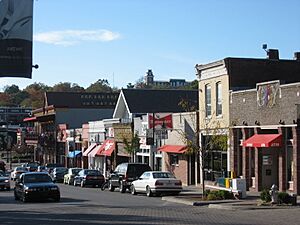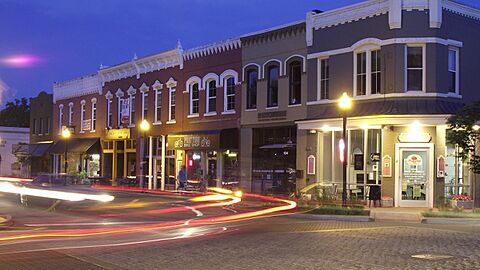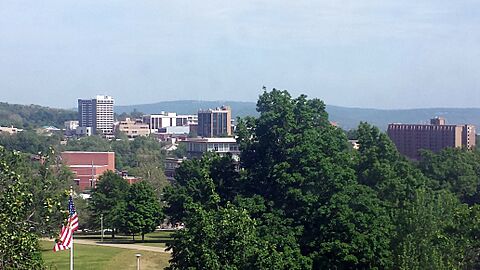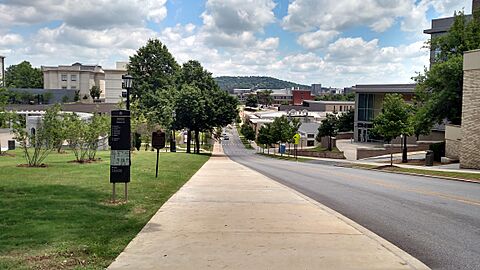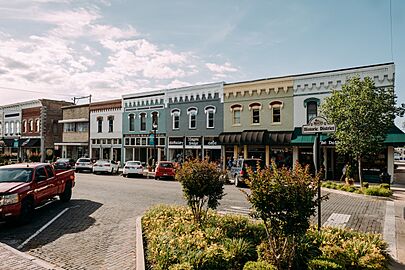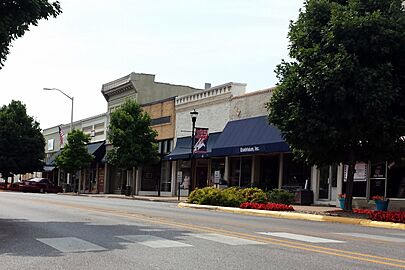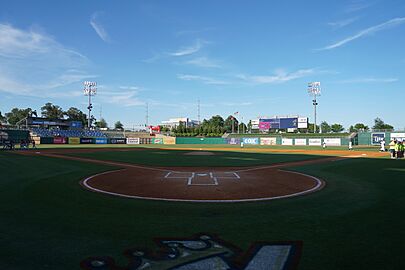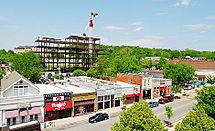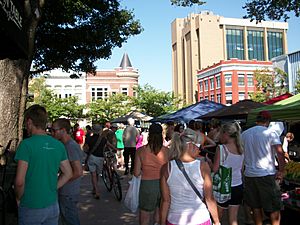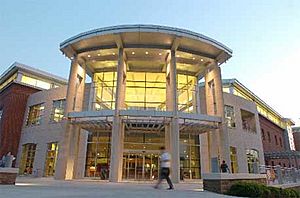Northwest Arkansas facts for kids
Quick facts for kids
Northwest Arkansas
|
|
|---|---|
| Fayetteville–Springdale–Rogers, AR Metropolitan Statistical Area |
|
|
Clockwise from top: Fayetteville within the Ozark Mountains, Crystal Bridges Museum of American Art, downtown Rogers, downtown Springdale, Donald W. Reynolds Razorback Stadium
|
|
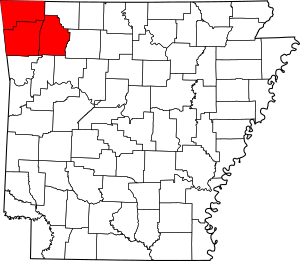
Map of Fayetteville–Springdale–Rogers, AR
Metropolitan Statistical Area |
|
| Country | |
| State | |
| Largest cities | Fayetteville Springdale Rogers Bentonville |
| Other Municipalities | Elm Springs Bella Vista Siloam Springs Centerton Lowell Farmington Huntsville |
| Area | |
| • Total | 3,213.01 sq mi (8,321.7 km2) |
| Population
(2023)
|
|
| • Total | 590,337 (98th) |
| • Density | 174/sq mi (67/km2) |
| Time zone | UTC-6 (CST) |
| • Summer (DST) | UTC-5 (CDT) |
| Area code(s) | 479 |
| Highest elevation 2515 ft/767 m Lowest elevation 800 ft/244 m (sea level) at Beaver Lake. |
|
Northwest Arkansas (NWA) is a growing area in Arkansas. It is located within the Ozark Mountains. This region includes four of Arkansas's largest cities. These are Fayetteville, Springdale, Rogers, and Bentonville. It also includes nearby towns in Benton and Washington counties. The area is also known as the Fayetteville–Springdale–Rogers Metropolitan Statistical Area. It covers about 3,213 square miles (8,322 square kilometers). As of 2023, about 590,337 people live here. This makes NWA the 98th most populated metropolitan area in the U.S. It is also the 13th fastest-growing area in the country.
NWA's population doubled between 1990 and 2010. This growth is thanks to three big companies based here. They are Walmart, Tyson Foods, and J.B. Hunt Transport Services, Inc.. More than 1,700 other businesses have also moved to the area. These companies supply the larger businesses. NWA has also invested in fun places to visit. These include the Crystal Bridges Museum of American Art, the Walmart AMP, and the NWA Razorback Regional Greenway trail.
Contents
What's in a Name?
The name "Northwest Arkansas" refers to the fast-growing cities in Benton and Washington counties. These counties are in the corner of the state. People often call it NWA. The Northwest Arkansas Council helped make the region known. This group of leaders started in 1990. They wanted to help the area work together and grow.
One of the first times the name was used was in 1937. A newspaper called the Fayetteville Daily Democrat changed its name to the Northwest Arkansas Times. Another big project using the name was the Northwest Arkansas National Airport. It opened in 1998. People often call it XNA. Other important projects include Interstate 49 and the Northwest Arkansas Community College (NWACC). The Northwest Arkansas Naturals baseball team and the Northwest Arkansas Razorback Regional Greenway trail are also part of the region. This trail is 36 miles (58 km) long.
Sometimes, people call the region "the 479." This is because of the telephone area code. But the Fort Smith metro also uses this area code. The Fort Smith area is usually not part of NWA. It is in a different geographic area.
Exploring Northwest Arkansas
Northwest Arkansas is in the southern part of the United States. It is part of the Upper South region. This area is known for the Ozarks. The southern part of NWA is a high plateau. It has many oak-hickory forests. These forests separate NWA from the Arkansas River Valley to the south.
 |
Four State Area | Ozark Mountains | Ozark Mountains |  |
| Green Country | Ozark Mountains | |||
| Green Country | Fort Smith metropolitan area | Arkansas River Valley |
Major Cities in NWA
More than half of NWA's people live in its four largest cities. Each city has unique features.
Fayetteville: Home of the Razorbacks
Fayetteville is the main city of Northwest Arkansas. It is the county seat of Washington County. The University of Arkansas is located here. In 2020, about 93,949 people lived in Fayetteville. It is the second-largest city in Arkansas. Fayetteville is famous for Dickson Street. This street is a popular place for entertainment. It has the Walton Arts Center. Near Dickson Street is the Fayetteville Historic Square. This square hosts a top-ranked farmer's market.
Springdale: Chicken Capital
Springdale is in Washington and Benton Counties. Its population was 87,315 in 2020. Springdale is Arkansas's fourth-largest city. It is home to Tyson Foods Inc. This is the world's largest meat company. Because of Tyson Foods, Springdale is called the "Chicken Capital of the World." The Northwest Arkansas Naturals baseball team plays here. Their home is Arvest Ballpark.
Rogers: A Great Place to Live
Rogers is in Benton County. In 2020, about 69,913 people lived here. It is the sixth most populated city in Arkansas. BusinessWeek magazine once ranked Rogers as one of the best affordable suburbs. CNN Money also called it one of the best places to live in the U.S. Two popular spots are the Walmart AMP, an outdoor concert venue, and the Pinnacle Hills Promenade shopping mall.
Bentonville: Walmart and Art
Bentonville is the county seat of Benton County. In 2020, its population was 54,210. It is Arkansas's ninth-largest city. Bentonville is home to the headquarters of Walmart. Walmart is the world's biggest retailer. It also has the Crystal Bridges Museum of American Art. This museum was started by Alice Walton, Sam Walton's daughter. It has many famous American artworks. It also features Frank Lloyd Wright's Bachman-Wilson House.
City Views
Land and Water Features

NWA is in the Ozark Mountains. This area has many hills and valleys. The Ozarks are the largest mountain region between the Appalachians and the Rocky Mountains. The land changes from the Boston Mountains in the south to the Springfield Plateau in the north. The Boston Mountains have steep, sharp hills. The Springfield Plateau has softer land. Most of the Ozarks are covered by oak-hickory-pine forests. About 25% of these forests have been cleared for towns and farms.
Most of NWA's water flows into the White River. Some western parts flow into the Illinois River. The White River has several dams. The most important one forms Beaver Lake. This lake was made in the 1960s. It helps control floods and provides water for most of NWA. The Illinois River is a sensitive area. It has had issues with too much phosphorus. This has led to efforts to keep the water clean.
Parks and Outdoor Fun
Northwest Arkansas is known for its beautiful nature. It offers many outdoor activities. The Northwest Arkansas Naturals baseball team was named after the region's natural beauty. NWA has thousands of acres of public land. Even with new buildings, over half of Washington County and 40% of Benton County were still forested in 2015.
A large network of trails has been built. The main trail is the Northwest Arkansas Razorback Regional Greenway. It is a 38-mile (61 km) paved trail. It connects the major cities, schools, parks, and cultural spots. This trail also links to 68 miles (109 km) of other paved trails. There are also over 100 miles (160 km) of dirt trails. NWA is a great place for mountain biking. It was the first region to be named a 'Regional Ride Center' in 2015.
Beaver Lake is a very popular water spot. It has about 449 miles (723 km) of natural shoreline. You can find limestone bluffs, caves, and many trees. The lake has twelve parks with campsites. These parks offer electricity, showers, and restrooms. You can also find picnic spots, swimming beaches, and boat ramps. Nine rivers nearby are great for canoeing or paddling. These include the Buffalo National River and the Illinois River.
The Botanical Garden of the Ozarks opened in 2007. It has seasonal plants, a wildflower meadow, and a hiking trail.
National and State Parks
The Ozark National Forest is a large protected area. The region also has three state parks. Hobbs State Park - Conservation Area is the largest state park in Arkansas. Devil's Den State Park is popular for hiking and camping. Prairie Grove Battlefield State Park tells the story of a Civil War battle.
Culture and Daily Life
Art and Entertainment Spots
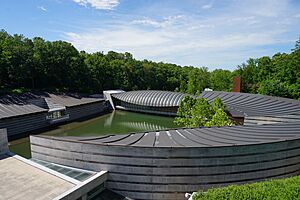
The Crystal Bridges Museum of American Art in Bentonville opened in 2011. It was funded by Alice Walton. The museum has a permanent collection of art. It also hosts new exhibits throughout the year.
The Walton Arts Center in Fayetteville is Arkansas's largest performing arts center. It opened in 1992. It hosts many musicals, plays, and other events. It is also home to the Symphony of Northwest Arkansas.
TheatreSquared is a professional theater in NWA. It puts on several plays each year. The Arts Center of the Ozarks in Springdale is the region's oldest community theater. It offers plays, art exhibits, and classes.
The Wal-Mart Visitors Center is on the Bentonville square. It is in Sam Walton's first variety store. It shows how Wal-Mart started and grew.
Dickson Street in Fayetteville is the main entertainment area. It is near the University of Arkansas. The street has many restaurants, bars, and shops. It hosts the Bikes, Blues, and BBQ Festival.
Fun Festivals and Events
- Bikes, Blues, & BBQ: A motorcycle rally on Dickson Street in Fayetteville. Over 400,000 people attend this four-day event.
- Bentonville Film Festival: Started in 2015. It takes place in early May. Over 85,000 people attend this week-long event.
- Dogwood Festival: Held in Siloam Springs since 1974. It brings about 30,000 people for three days. It features food, crafts, and entertainment.
- Walmart Shareholder's Meeting: Brings over 5,000 Walmart employees to Fayetteville.
- World Championship Squirrel Cook Off: Held in Bentonville since 2011.
- Battle of Prairie Grove Reenactment: Hundreds of Civil War reenactors camp and fight. It happens in December of even-numbered years at Prairie Grove Battlefield State Park.
- Format Festival: Started in 2022 in Bentonville. It combines music, art, and technology.
Sports and Teams

Sports are a big part of Northwest Arkansas. This is mainly because of the University of Arkansas Razorbacks. The Razorbacks are Arkansas’ most popular sports teams. They bring many fans from all over the state.
The Razorbacks have 19 men's and women's teams. They play in 13 different sports. These include baseball, basketball, football, and track and field. They compete in NCAA Division I. Their home facilities include Reynolds Razorback Stadium and Bud Walton Arena.
In 2008, a Double-A minor league baseball team moved to Springdale. They became the Northwest Arkansas Naturals. They play at Arvest Ballpark.
In 2023, the United Soccer League announced new soccer teams for NWA. These teams will play in a new stadium in Rogers.
Who Lives in Northwest Arkansas?
| Historical population | |||
|---|---|---|---|
| Census | Pop. | %± | |
| 1840 | 12,151 | — | |
| 1850 | 18,503 | 52.3% | |
| 1860 | 31,719 | 71.4% | |
| 1870 | 39,328 | 24.0% | |
| 1880 | 55,627 | 41.4% | |
| 1890 | 77,142 | 38.7% | |
| 1900 | 85,731 | 11.1% | |
| 1910 | 83,334 | −2.8% | |
| 1920 | 86,639 | 4.0% | |
| 1930 | 87,842 | 1.4% | |
| 1940 | 91,793 | 4.5% | |
| 1950 | 99,789 | 8.7% | |
| 1960 | 101,137 | 1.4% | |
| 1970 | 137,299 | 35.8% | |
| 1980 | 189,982 | 38.4% | |
| 1990 | 222,526 | 17.1% | |
| 2000 | 325,364 | 46.2% | |
| 2010 | 440,121 | 35.3% | |
| 2020 | 546,725 | 24.2% | |
| 2023 (est.) | 590,337 | 34.1% | |
| U.S. Decennial Census 1790–1960 1900–1990 1990–2000 2010–2016 |
|||
Northwest Arkansas is the second-largest population center in the state. It is growing very fast. Between 2010 and 2020, its population grew by over 24%. NWA is not like a single big city with suburbs. Instead, it is a group of cities that grew together over time. The official name, Fayetteville–Springdale–Rogers Metropolitan Statistical Area, lists the three largest cities.
The four largest cities, Fayetteville, Springdale, Rogers, and Bentonville, hold over half of NWA's population. Each city has different types of people. Fayetteville, with the University of Arkansas, has many college graduates. Bentonville, with Walmart's headquarters, has many people who work in offices. Springdale and Rogers have many people who work in factories and construction. They also have large populations of people born in other countries.
About half of the people in Northwest Arkansas moved here from other states or countries. They often come for jobs and a lower cost of living.
| County Ref. |
Population | Land mi2 |
Land km2 |
Pop. /mi2 |
Pop. /km2 |
|---|---|---|---|---|---|
| Benton County | 258,291 | 847.36 | 2,194.65 | 261.2 | 100.85 |
| Washington County | 228,049 | 941.97 | 2,439.69 | 215.6 | 83.24 |
| Madison County | 16,072 | 834.26 | 2,160.72 | 18.8 | 7.26 |
| Northwest Arkansas | 525,032 | 3,163.07 | 8,192.31 | 166.0 | 64.09 |
| Arkansas | 2,988,248 | 52,035.48 | 134,771.27 | 56.0 | 21.62 |
Economy and Jobs
Northwest Arkansas has a strong economy. It has seen a huge increase in population. Many people move here from other parts of Arkansas and other states. They come for jobs in this growing area. Between 1990 and 2000, Benton and Washington counties grew by 47%. Even when the national economy was slow, NWA's job growth was good. In 2008, the unemployment rate was 4.1%.
Bentonville is known worldwide as a retail center. This is because Walmart has its headquarters there. Springdale is home to Tyson Foods. It is the world's top producer of chicken and beef. J.B. Hunt Transport Services in Lowell is a very large trucking company. It has networks in Canada and Mexico.
Many people have moved to NWA from bigger cities. They come for jobs and fun things to do. The cost of living is lower here. Places like Pinnacle in Rogers have grown. They offer amenities for new residents. This has changed the towns from small and quiet to busy and lively.
Learning and Getting Around
Education in NWA

Northwest Arkansas has a long history of education. The first college in Arkansas, Cane Hill College, was founded here in 1834. Today, the University of Arkansas in Fayetteville is the largest and best-known university in the state. It started in 1871. Seven of the top ten school districts in Arkansas are in Benton or Washington counties. This includes Haas Hall Academy.
In 2016, most NWA residents over 25 had a high school degree. Many also had a bachelor's degree. These rates are higher than the average for Arkansas.
Schools for Kids
Public schools in Northwest Arkansas range from small country schools to some of the state's largest. The four big cities each have high schools. For example, Bentonville has Bentonville and Bentonville West. Rogers has Rogers and Rogers Heritage. Springdale has Springdale and Springdale Har-Ber. These schools are part of the largest athletic conference in the state. New schools are being built as the region grows.
There are also private schools and charter schools. Shiloh Christian School in Springdale is one example.
Colleges and Universities
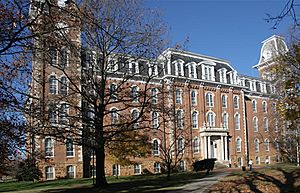
- University of Arkansas (UA): This is a public university in Fayetteville. It is known for its architecture, agriculture, writing, and business programs. It is also home to the Arkansas Razorbacks sports teams.
- John Brown University
- Northwest Arkansas Community College (NWACC)
- Ecclesia College
Libraries for Everyone
The Fayetteville Public Library is the biggest library in Northwest Arkansas. Other libraries in Washington County work together as the Washington County Library System.
Getting Around NWA
The main highway in the region is Interstate 49. It is being made wider to six lanes. Other important highways include US 62 and US 71.
Airports
Northwest Arkansas National Airport (XNA) is the main airport for flights. It opened in 1998. It has one concourse with twelve gates. Popular destinations include Dallas/Fort Worth, Atlanta, and Chicago. XNA also has flights from Allegiant Air, a low-cost airline.
There are seven smaller airports for private planes. These include Drake Field and Rogers Executive Airport.
Buses and Public Transport
Two bus services operate in the area. Ozark Regional Transit has local routes and special services. Razorback Transit mainly serves University of Arkansas students. It is free to ride and also open to the public.
Long-distance bus service is available from Jefferson Lines in Fayetteville.







